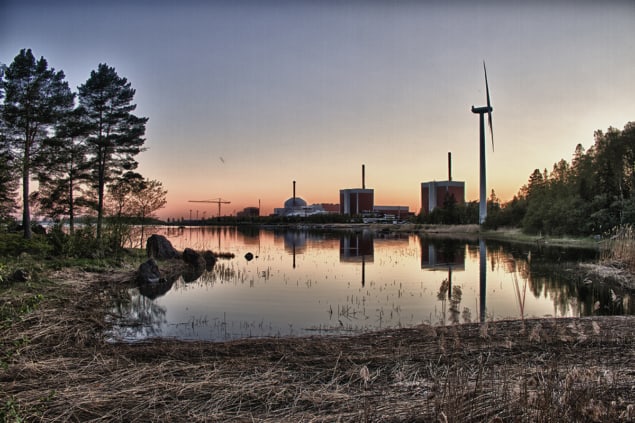Robert P Crease discovers why a nuclear-waste programme in Finland can help us to envisage the world a million years from now

The Greek philosopher Plato once imagined a city that provides full justice to its citizens. Setting out his ideas in the Republic almost 2500 years ago, Plato did not, however, think that such a city could ever be realized. Radical (and surely unachievable) transformations in education, culture and government would be required to establish and sustain it. “Ridiculous,” Plato concluded.
In a similar vein, the US cultural anthropologist Vincent Ialenti envisions a fictional city whose citizens have been trained to think so that humans don’t need to flee the planet to survive. So utopian is the picture that Ialenti – writing in his new book Deep Time Reckoning – calls it “absurd”. Yet that notion is no less absurd, he continues, than the way humans are now acting, “careening toward an Anthropocene cliff”.
Based at George Washington University, Ialenti developed this picture by drawing on three years of fieldwork in Finland, where he’d studied experts who were evaluating the risks of a permanent repository for nuclear waste. The experts had been asked to develop methods to convince Finnish regulators that the facility, being cut out of granite bedrock underneath the island of Olkiluoto, would not expose future populations – thousands and even hundreds of thousands of years from now – to radiation above the country’s legal limits.
Long-term predictions face enormous scepticism and deeply embedded resistance from the public and government officials, especially when they concern global matters
The Finnish experts developed various strategies to envision “deep time”. For example, they implemented unusual computer modelling methods to integrate a variety of datasets, scenarios, maps and reports over an unprecedented range of issues, including climate change, geological events, shorelines, human demographics, vegetation growth and ecosystems. For clues on the long-term evolution of materials and planetary landscapes, they studied everything from ancient Roman nails and 2100-year-old Chinese cadavers to cannons from a sunken 17th-century Swedish warship and traces of a crater in Finland caused by a meteor 73 million years ago.
Playing the long game
Ialenti is fully aware of the deficiencies and partialities of the Finnish project and of his own study. Sample size was one concern, based as it was on just two dozen experts from a single firm associated with the nuclear-power industry. Another was the fact that Finland is the most sparsely populated country in the European Union. Finland also has a much higher public trust of scientists and technical experts – certainly higher than other large nations such as mine, where tens of millions of citizens can vote for leaders who think that consulting scientific advice is for losers.
Furthermore, contemporary humans are soaked in a world of tools, technologies and institutions that reinforce short-term – rather than long-term – thinking. Decisions about buying and selling stocks must be made in seconds, apps can be updated every few weeks, and start-up companies must rethink their plans every year or so. Long-term predictions face enormous scepticism and deeply embedded resistance from the public and government officials, especially when they concern global matters.
Somewhere in deep time looms a catastrophe that we don’t yet have the imagination to envision, nor the will to confront
Climate-change predictions, even for 2050, seem hopelessly far in the future, and tainted by politics, guesswork and subjectivity. Thinking about the present seems more do-able, while thinking about tens or hundreds of thousands of years in the future appears starry-eyed and abstract. But Ialenti believes the exact opposite is true. What’s abstract (in the sense of detached from reality) is what Ialenti calls “a manic fixation on the present”, and not being able to think about humanity thousands of years hence.
Ialenti is less interested in the conclusions reached by the Finnish experts than by their audacious aims, which are to develop methods to break free from what he calls our “shallow time discipline”. He then tries to devise ways to retrain our habits to encourage humans to think long-term; for him, Deep Time Reckoning is not a stale academic treatise but more of a “practical toolkit”.
This toolkit includes high-school civics classes devoted to teaching long-term developments: of the universe since the Big Bang 13.8 billion years ago; of Earth since 4.5 billion years ago; of Earth’s life, dinosaurs and humans; and of the evolution of languages and technologies. It envisions school pupils reading about futuristic visions by Ray Kurzweil and Marxist descriptions of world utopias.
Ialenti even asks his university students to examine the tools that the insurance industry uses to protect companies against future calamities, and the methods that the Catholic Church uses to maintain institutional continuity. Practised over generations, Ialenti thinks, such an education would eventually make deep time thinking “less wacky and aloof”, and more second-nature.

Green technology and growth: a vision we can believe in
Ialenti proposes a range of details in his deep-time-thinking world that are more New Atlantis than Republic. His deep-time-thinking world has monuments, but they are to volcanoes, glaciers, asteroid collisions and other testimonials to deep time. Internet competitions and TV gameshows are devoted to preparations for and speculations about the future. Even the screensavers of his utopian world remind computer users of deep time. The United Nations, meanwhile, might support institutions with names like “Global Deep Time Reckoning Association”, precursors to which, he thinks, already exist in organizations like the Planetary Society and the Aspen Institute, a global non-profit think tank.
The critical point
Plato meant the Republic to be a beacon for humans to think about justice in the present, not as the blueprint for an actual city to be realized in the future. After all, if you head straight towards a lighthouse, you usually end up on the rocks.
Somewhere in deep time looms a catastrophe that we don’t yet have the imagination to envision, nor the will to confront. Ialenti thinks he finds in the Finnish nuclear-risk experts glimmerings of what it might take to cultivate the human behaviour needed to do so. Humanity’s long-range hope, Ialenti suggests, hangs on what we might call the Finlandization of the planet.



